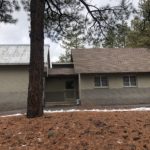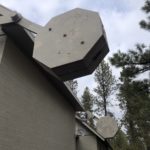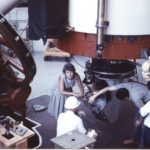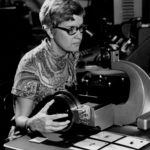
Photo: the exterior of the Chalet | Madison Mooney
Tucked away amongst the trees in a secluded corner of Lowell’s Flagstaff campus lies the Mars Hill Chalet, an unusual building where some truly dark discoveries were made.
Trial and Error
The Chalet was originally built in 1962, with its left wing constructed to house the Ronnie-Morgan 24-inch reflecting telescope. A laboratory and living quarters for employees were later added onto the original building, and are still used today as lodging for visiting astronomers. The gabled roof opened like a clamshell to expose the telescope to the sky, while the four hexagonal cement blocks hanging off the sides of the roof served as counterweights. Though they haven’t served their intended purpose in many years, the blocks remain in place as an unconventional reminder of the past.
Like many other buildings on Lowell’s campus, the Chalet represents an experiment in stargazing technology—and as any scientist knows, with experimentation often comes failure. Though the roof’s shape gave the Chalet an attractive alpine feel, its design proved ineffective in standing up to Flagstaff’s strong winds as the open panels would shake back and forth during particularly strong gusts.
- Another outside view of the Chalet.
- The lounge area of the living quarters.
- A closer look at the counterweights.
A Dark Discovery
The Ronnie-Morgan 24-inch telescope was primarily used to develop an instrument called the Carnegie Image Tube Spectrograph, a device created by a team that was led by Kent Ford and included longtime Lowell astronomer Otto Franz and Lowell Advisory Board member Vera Rubin. The instrument allowed telescopes to observe objects that were many times fainter than those that had been studied in the past.
Using the spectrograph, Ford’s team was able to study the Andromeda Galaxy. Up until then, astronomers had assumed that a galaxy’s gravity was strongest at its core, therefore stars located near the core would move faster than those that were further away. However, when the data from Andromeda was analyzed, the team noticed a phenomenon that contradicted this idea. The stars on the outskirts of the galaxy moved at the same speed as those at its center. Vera Rubin theorized that there must be an invisible force at work—matter that was too dark to be seen from Earth. Though the theory of dark matter had been presented in the past, it had never before been supported by observable evidence.
Today, the Chalet stands as a piece of living history. It serves as a stop along the Universe Walk on the western end of campus, a trail lined with bronze busts of influential figures throughout the history of astronomy.
- Vera Rubin with the Ronnie-Morgan Telescope in 1965 | Carnegie Institution
- Kent Ford shows where the image tube spectrograph was located in a photo of Vera Rubin and himself inspecting the telescope | Michael Lucibella
- Otto Franz
- Vera Rubin | Carnegie Institution of Washington
Check out Secrets of Lowell on Tiktok!
@lowellobservatoryWho’s ready to delve into some dark secrets? 🌑🔭 Visit lowell.edu/thechalet for more! #womeninstem #verarubin #darkmatter #astronomy #ThisorThatSBLV






